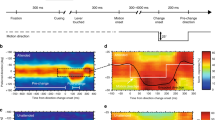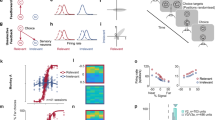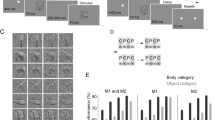Abstract
Flexible links between sensory stimuli and behavioral responses underlie many cognitive processes. One process that contributes to flexible decision-making is categorization. Some categories are innate or overlearned, but, in many cases, category boundaries represent flexible decision criteria that can shift on the fly to adapt to changes in the environment. The ability to shift category boundaries allows decision-making to adapt to changing circumstances. We found that monkeys were able to switch rapidly between two category boundaries when classifying the speed of a moving dot pattern and that neurons in monkey frontal eye field (FEF) changed their activity when the boundary changed. The responses of a subpopulation of FEF neurons that were sensitive to both stimulus and boundary speed were used to classify the stimuli as accurately as the monkeys' performance.
This is a preview of subscription content, access via your institution
Access options
Subscribe to this journal
Receive 12 print issues and online access
$209.00 per year
only $17.42 per issue
Buy this article
- Purchase on Springer Link
- Instant access to full article PDF
Prices may be subject to local taxes which are calculated during checkout





Similar content being viewed by others
References
Ferrier, D. The Functions of The Brain (Putnam. New York, 1876).
Bruce, C.J., Goldberg, M.E., Bushnell, M.C. & Stanton, G.B. Primate frontal eye fields. II. Physiological and anatomical correlates of electrically evoked eye movements. J. Neurophysiol. 54, 714–734 (1985).
Schall, J.D., Hanes, D.P., Thompson, K.G. & King, D.J. Saccade target selection in frontal eye field of macaque. I. Visual and premovement activation. J. Neurosci. 15, 6905–6918 (1995a).
Moore, T. & Armstrong, K.M. Selective gating of visual signals by microstimulation of frontal cortex. Nature 421, 370–373 (2003).
Thompson, K.G., Biscoe, K.L. & Sato, T.R. Neuronal basis of covert spatial attention in the frontal eye field. J. Neurosci. 25, 9479–9487 (2005).
Peng, X., Sereno, M.E., Silva, A.K., Lehky, S.R. & Sereno, A.B. Shape selectivity in primate frontal eye field. J. Neurophysiol. 100, 796–814 (2008).
Xiao, Q., Barborica, A. & Ferrera, V.P. Radial motion bias in macaque frontal eye field. Vis. Neurosci. 23, 49–60 (2006).
Bichot, N.P., Schall, J.D. & Thompson, K.G. Visual feature selectivity in frontal eye fields induced by experience in mature macaques. Nature 381, 697–699 (1996).
Ferrera, V.P., Cohen, J.K. & Lee, B.B. Activity of prefrontal neurons during location and color delayed matching tasks. Neuroreport 10, 1315–1322 (1999).
Ratcliff, R. & McKoon, G. The diffusion decision model: theory and data for two-choice decision tasks. Neural Comput. 20, 873–922 (2008).
Horwitz, G.D., Batista, A.P. & Newsome, W.T. Representation of an abstract perceptual decision in macaque superior colliculus. J. Neurophysiol. 91, 2281–2296 (2004).
Miller, E.K., Nieder, A., Freedman, D.J. & Wallis, J.D. Neural correlates of categories and concepts. Curr. Opin. Neurobiol. 13, 198–203 (2003).
Gopnik, A. & Meltzoff, A. The development of categorization in the second year and its relation to other cognitive and linguistic developments. Child Dev. 58, 1523–1531 (1987).
Campbell, R.N. Categorization, early concepts and first language acquisition. in Encyclopedia of Language & Linguistics 4 (eds Asher, R. & Simpson, J.M.Y.) 1899–1904 (Elsevier, Amsterdam, 1994).
Ashby, F.G. & Maddox, W.T. Human category learning. Annu. Rev. Psychol. 56, 149–178 (2005).
Freedman, D.J., Riesenhuber, M., Poggio, T. & Miller, E.K. Categorical representation of visual stimuli in the primate prefrontal cortex. Science 291, 312–316 (2001).
Freedman, D.J. & Assad, J.A. Experience-dependent representation of visual categories in parietal cortex. Nature 443, 85–88 (2006).
Maunsell, J.H. & Newsome, W.T. Visual processing in monkey extrastriate cortex. Annu. Rev. Neurosci. 10, 363–401 (1987).
Kreiman, G., Koch, C. & Fried, I. Category-specific visual responses of single neurons in the human medial temporal lobe. Nat. Neurosci. 3, 946–953 (2000).
Sigala, N. & Logothetis, N.K. Visual categorization shapes feature selectivity in the primate temporal cortex. Nature 415, 318–320 (2002).
Freedman, D.J., Riesenhuber, M., Poggio, T. & Miller, E.K. A comparison of primate prefrontal and inferior temporal cortex during visual categorization. J. Neurosci. 23, 5235–5246 (2003).
Farah, M.J. Visual Agnosia (MIT Press, Cambridge, Massachusetts, 2004).
Sereno, A.B. & Maunsell, J.H. Shape selectivity in primate lateral intraparietal cortex. Nature 395, 500–503 (1998).
Schall, J.D., Morel, A., King, D.J. & Bullier, J. Topography of visual cortex connections with frontal eye field in macaque: convergence and segregation of processing streams. J. Neurosci. 15, 4464–4487 (1995).
Blair, M.R., Watson, M.R., Walshe, R.C. & Maj, F. Extremely selective attention: eye-tracking studies of the dynamic allocation of attention to stimulus features in categorization. J. Exp. Psychol. Learn. Mem. Cogn. 35, 1196–1206 (2009).
Opris, I., Barborica, A. & Ferrera, V.P. On the gap effect for saccades evoked by electrical microstimulation of frontal eye fields in monkeys. Exp. Brain Res. 138, 1–7 (2001).
Acknowledgements
We would like to thank J. Schall, R. Ratcliff, F. Pestilli, J. Grinband, T. Teichert, C. Barberini and M. Phillips for comments on a preliminary version of this manuscript. This research was supported by US National Institutes of Health grant MH59244 (V.P.F.), the Gatsby Institute (V.P.F.), the National Alliance for Research on Schizophrenia and Depression (V.P.F.) and the Robert Leet and Clara Guthrie Patterson Trust (M.Y.).
Author information
Authors and Affiliations
Contributions
V.P.F., M.Y. and C.C. designed the experiments, analyzed the data and wrote the manuscript. M.Y. and C.C. carried out the experiments.
Corresponding author
Supplementary information
Supplementary Text and Figures
Supplementary Figures 1–5, Supplementary Results and Supplementary Methods (PDF 4089 kb)
Rights and permissions
About this article
Cite this article
Ferrera, V., Yanike, M. & Cassanello, C. Frontal eye field neurons signal changes in decision criteria. Nat Neurosci 12, 1458–1462 (2009). https://doi.org/10.1038/nn.2434
Received:
Accepted:
Published:
Issue Date:
DOI: https://doi.org/10.1038/nn.2434
This article is cited by
-
Category representation in primary visual cortex after visual perceptual learning
Cognitive Neurodynamics (2024)
-
Causal role for the primate superior colliculus in the computation of evidence for perceptual decisions
Nature Neuroscience (2021)
-
Causal contributions of human frontal eye fields to distinct aspects of decision formation
Scientific Reports (2020)
-
Comparing frontal eye field and superior colliculus contributions to covert spatial attention
Nature Communications (2018)
-
Task-specific versus generalized mnemonic representations in parietal and prefrontal cortices
Nature Neuroscience (2016)



